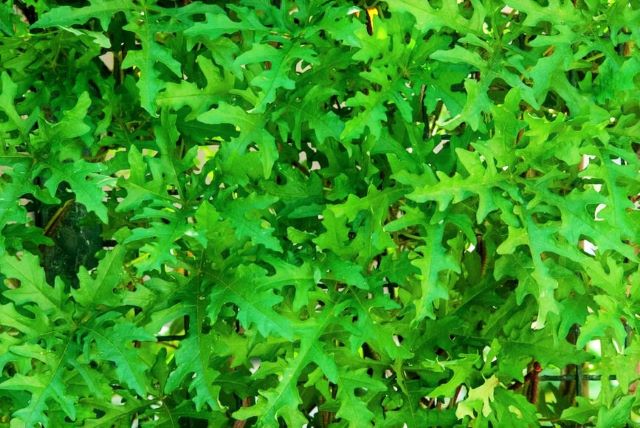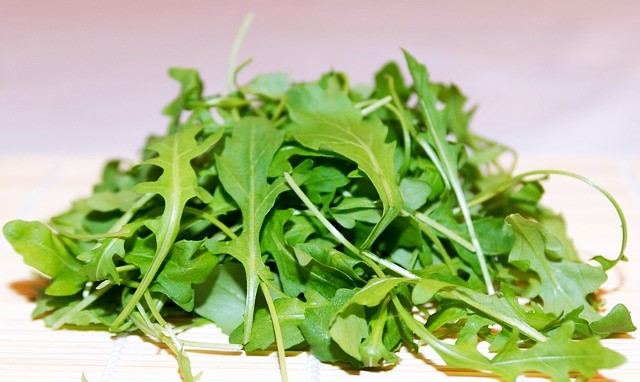Arugula is one of my favorite plants to grow in the garden. Its crisp, delicious green leaves are a great addition to salads, sandwiches, and pesto sauces. But it can also be difficult to grow, and you can run into problems like spots on arugula leaves. Here are some of the most common causes of spots on arugula, and solutions for them.

The most common causes of spots on arugula are the diseases Alternaria leaf spot, bacterial leaf spot, downy mildew, and blight; as well as aphids.
Lets find out more about these causes and how to fix them.
Related: Lettuce Pests And How to Get Rid of Them | Why Lettuce Is Dying (And How To Fix It!)
Table of Contents
Alternaria Leaf Spot Causes Brown Spots on Arugula Leaves
Alternaria is a fungal disease that can affect arugula plants. It causes small, reddish-brown spots on the upper surface of arugula leaves. These spots often have white or gray centers.
Eventually, the spots can encircle the leaves and spread to the stems, and then the arugula will start to wilt. This fungus thrives in warm, wet environments.
Solutions for Alternaria Leaf Spot on Arugula
As a fungal disease, Alternaria can be hard to treat. But that doesn’t mean it’s impossible.
First, prevention is very important. Alternaria thrives in environments that are warm, wet, and cramped. So give your arugula plenty of space to breathe, and don’t let the plants crowd each other. Also, try to avoid getting the leaves wet by only watering at the base of the plants instead of overhead watering.
An organic citric acid-based fungicide like this one can help kill Alternaria and other fungal diseases. If this doesn’t work, the best thing you can do is remove any infected parts of the arugula, or whole plants. You don’t want this disease to spread to the rest of your delicious plants.
Can You Eat Arugula with Alternaria Leaf Spot?
Because Alternaria is a fungal disease that wilts arugula rapidly, you should avoid eating leaves that have been infected. The arugula might not be good anymore.
So if you notice small, reddish-brown spots on the top of your arugula leaves, know that it’s likely Alternaria, and you don’t want to eat those leaves.
Bacterial Leaf Spot Creates Brown Spots on Arugula Leaves
Another type of brown spots on arugula leaves can come from bacterial leaf spot. Unlike Alternaria, this is a bacterial disease, not fungal. It causes brown, water-soaked spots on the leaves of arugula plants. Eventually, the leaves will turn yellow and wilt.
This disease is more common in colder temperatures. It spreads through moisture, and can also be carried in the seeds of arugula plants. It’s important to take steps to prevent your arugula from getting bacterial leaf spot.
Solutions for Bacterial Leaf Spot on Arugula
First, since bacterial leaf spot likes cold temperatures and can be carried in arugula seeds, it’s a good idea to treat your seeds with heat before planting. To do this, heat water to between 100 and 122 degrees Fahrenheit. Then soak your seeds in this heated water for about 15 minutes. This won’t damage your seeds, and will help kill off bacterial leaf spot, and possibly other diseases as well.
There are other ways to prevent and treat bacterial leaf spot. Again, avoid getting the leaves wet, watering only the base of the plants. When leaves are wet, try to avoid damaging or moving them, as this can encourage the spread of the disease.
Rotating planting locations can also help prevent bacterial leaf spot. Once you notice the brown spots appear, you can spray your arugula with a bit of neem oil in water. This will help kill the bacteria.
Lastly, if the above doesn’t work, remove any infected parts, or entire plants. This will prevent the leaf spot from spreading to the rest of your crop.
Can You Eat Arugula With Bacterial Leaf Spot?
Again, this disease rots arugula, and wilts the leaves. So it’s best to avoid eating arugula infected with bacterial leaf spot.
Downy Mildew Causing Brown and White Spots on Arugula
Downy mildew is another fungal disease that affects arugula plants. Once again, it can cause brown spots on the leaves. But an easy way to differentiate it from other diseases is that it also leaves white mildewy spots on the undersides of arugula leaves.
Solutions for Downy Mildew on Arugular Leaves
This fungus can travel far on the wind, and poor air circulation and excessive moisture help it thrive. So make sure your arugula plants are spread out, and not crowding each other. Again, try to only water near the base, and avoid getting the foliage wet.
The organic fungicide mentioned above will also help treat downy mildew, so you should give that a try if you notice that it’s taken hold. And like other diseases, if all else fails, the best thing you can do is remove any infected parts, to prevent it from spreading to the rest of your garden.
Can You Eat Arugula with Downy Mildew Spots?
Once again, the best answer is no. This disease wilts the plant, and you don’t want to eat arugula that has started to wilt and die. If you notice brown spots and white mildewy specks, it’s best to avoid eating those arugula leaves.
Blight Causes Brown or Gray Spots on Arugula Leaves
Blight is a fungal disease that lives in the soil. This can make it very hard to treat or prevent. It creates brown or brown-gray spots on arugula leaves, which leads to wilting.
Solutions for Blight on Arugula Plants
Avoid getting arugula leaves wet, and don’t overwater them, so the roots aren’t sitting in excess water. Also, make sure plants have plenty of room to promote air circulation. Consider planting arugula in pots or raised beds, as this makes it harder for blight to take hold.
If you notice signs of blight, you should try an organic fungicide, as soon as you can. If you treat it soon enough, you can get your arugula back on track. And if not, remove infected plants immediately to help prevent the blight from spreading.
Once blight takes hold, it can live in the soil for years. Because of this, you’ll need to make some changes. If your arugula is in a pot or raised bed, simply throw out the soil you’ve been using. If it’s in the ground, try planting arugula somewhere else, and leaving the soil empty for a while to let the fungus die out.
Can You Eat Arugula with Blight Spots?
Most people agree that yes, as long as it hasn’t wilted too much, you can eat arugula with blight spots, because blight isn’t harmful to people. If a leaf is mostly spots, though, you should avoid eating that one.
Aphids Leave Spots on Arugula Leaves
Lastly, this one isn’t a disease, but a pest that I hate: aphids. I’ve had to fight them off my arugula before, and they can be a real pain, but once you understand them, they’re a lot easier to deal with.
Aphids are tiny insects that like to feed on plants. They suck the sap out of arugula leaves, leaving discolored spots that can be white, yellow, or light green. They also leave a sticky white residue on arugula leaves, which makes them easy to identify. If left unchecked, they will cause the plant to wilt by eating the leaves.
How to Treat Aphids on Arugula Plants
The thing I’ve found to be most helpful is to make up a neem oil solution in a spray bottle, and spray your arugula down with that. It will kill the aphids, and prevent their eggs from hatching to create more of them.
You can also simply wash down the plant. Be gentle so you don’t damage the leaves, damaging them can promote the spread of diseases like the ones mentioned above. But a medium-pressure washing can knock off the aphids. Combining this with the spray is a good solution for aphids.
Lastly, you can try to attract helpful bugs which will eat the aphids. Ladybugs are your best bet, as they can eat the aphids without harming your arugula. You can buy ladybugs online if you want to introduce them into your garden as aphid-hunters.
Can You Eat Arugula with Aphids on It?

In short, yes. However, you’ll definitely want to wash the aphids off the arugula first, and don’t eat any leaves that have wilted. While aphids are safe to eat, they’re not very appetizing. So as long as you clean your arugula first, you can still enjoy its deliciousness, even if aphids have gotten to it!
Further reading:
